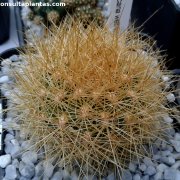Care of the cactus Matucana weberbaueri or Echinocactus weberbaueri |
|
The genus Matucana, family Cactaceae, comprises 20 species of cactus native to Peru. Some species are: Matucana weberbaueri, Matucana madisoniorum, Matucana intertexta, Matucana haynei, Matucana polzii, Matucana krahnii, Matucana auriantica. Scientific synonyms: Echinocactus weberbaueri, Borzicactus weberbaueri. This species is native to the Amazonas region, Peru. They are solitary, slow-growing cacti with a bright green globular-cylindrical body and depressed apex that reach 7 cm (2.75") in height. They have up to 21 ribs with rounded tubercles and elliptical areolas that have up to 30 spines 4 cm (1.57") long. The showy yellow or orange flowers are 6 cm (2.36") long and 3 cm (1.18") in diameter. They bloom during the spring. Echinocactus weberbaueri is used in pots for balconies and terraces, as indoor plants, greenhouse and in mini gardens for cacti and succulents. Matucana weberbaueri prefers full sun exposure but can grow in semi-shade. Good ventilation and low humidity are very important. In winter keep the plants at 6-10 ºC (43-50 ºF) to rest. Borzicactus weberbaueri can grow in poor, stony soils. Use a commercial cactus substrate with coarse sand. The transplant is done every 2-3 years in early spring. Matucana weberbaueri is very sensitive to excess moisture. Water moderately in spring and summer, waiting for the substrate to dry. Stop watering in late fall and throughout the winter. Fertilize once in spring with mineral fertilizer for cacti. Borzicactus weberbaueri does not need pruning. If ventilation is adequate and irrigation is moderate, they do not present problems of pests and diseases. Matucana weberbaueri propagates from seeds sown in spring in a seedbed under glass; sometimes they produce suckers. |
Images of the cactus Matucana weberbaueri or Echinocactus weberbaueri |
Find plants
Matucana weberbaueri or Echinocactus weberbaueri | Care and Growing
© 2026 FavThemes
